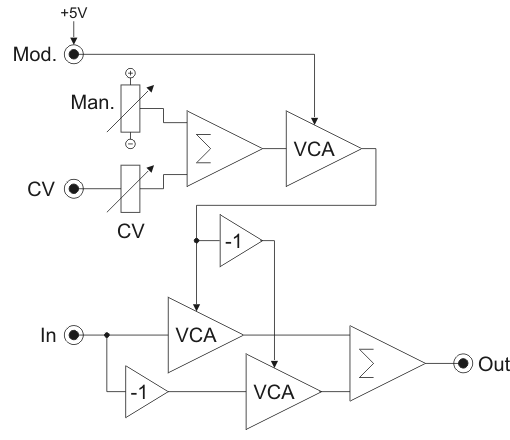A-133-2 Dual
Voltage Controlled VCA/Polarizer/Inverter/Ring Modulator
Slim Line Series

|
A-133-2 ist die schmale Version des A-133, verfügt aber über einige Zusatzfunktionen, die beim A-133 nicht verfügbar waren.
Das Modul A-133-2 kann für sehr
viele verschiedene Aufgaben verwendet werden: vom einfachen VCA über
spannungsgesteueren Polarizer und spannungsgesteuerten Inverter bis hin zum
gleichspannungsgekoppelten Ringmodulator. Im Prinzip beinhaltet das Modul zwei spezielle
spannungsgesteuerte Verstärker, die sowohl positive wie auch negative
Verstärkungen zulassen.
Die Verstärkung wird von der Stellung des manuellen Regler Man, der von außen
zugeführter Steuerspannung CV und der Stellung des Reglers CV
bestimmt, welche als Abschwächer für das extern zugeführte CV-Signal
arbeitet. Ohne
externes CV-Signal beträgt die Verstärkung +1, wenn der Regler Man auf
Rechtsanschlag steht. In der Mittelstellung des Reglers Man ist die Verstärkung
0 und bei Linksanschlag -1, d.h. das dem Eingang In zugeführte Signal erscheint
invertiert am Ausgang Out. Über die Steuerspannung CV kann die mit dem Regler
Man eingestellte Verstärkung zusätzlich moduliert werden, wobei der Regler CV
als Abschwächer für das extern über die Buchse CV zugeführte Signal dient.
Das Summensignal aus dem Regler Man und der von außen zugeführter
Steuerspannung CV nach Abschwächung mit dem CV-Regler bestimmt die aktuelle
Gesamtverstärkung.
Zusätzlich kann auch noch das CV-Signal noch über den
Modulationseingang Mod mit Hilfe einer weiteren Steuerspannung moduliert
werden. Die zugehörige Buchse Mod ist auf +5V normalisiert. Das bedeutet, dass eine
konstante positive Spannung verwendet wird, sofern über die Buchse Mod kein
zusätzliches Steuersignal für die Modulation des CV-Signals zugeführt wird.
Der Steuerspannungsbereich für den Mod-Eingang ist nullsymmetrisch und kann mit
Hilfe eines Trimmpotentiometers an die aktuellen Bedürfnisse angepasst werden.
Ab Werk ist die Empfindlichkeit auf einen Spannungsbereich von -5V...+5V
eingestellt (-5V = keine Modulation, 0V = 50% Modulation, +5V = volle
Modulation).
Die aktuelle Verstärkung wird mit einer zweifarbigen Leuchtdiode angezeigt. Es handelt sich
hier nicht um eine
Signalanzeige, sondern um die Anzeige der aktuellen Verstärkung (gelb = positive Verstärkung, rot = negative Verstärkung)
Anwendungsbeispiele:
-
spannungsgesteuerter Verstärker (VCA) bei rein positiver Gesamt-Steuerspannung (Man + CV)
-
spannungsgesteuerter Inverter bei rein negativer Gesamt-Steuerspannung (Man + CV)
-
spannungsgesteuerter Polarizer bei zwischen positiv und negativ wechselnder Gesamt-Steuerspannung (Man + CV)
-
gleichspannungsgekoppelter Ringmodulator mit Offset-Funktion (den "klassischen" Ringmodulator erhält man bei Man=0 und nullsymmetrischen Audio-Signalen für In und CV)
-
zusätzliche Effekte mit Hilfe der Modulation des CV-Signals durch den Mod-Eingang
Zusätzliche technische Informationen:
-
Eingangsspannungsbereich: ca. 14Vpp (-7 V ... +7 V), bei Signalen außerhalb dieses Bereichs beginnt das Signal zu clippen
-
maximale Abschwächung jedes VCAs: ca. -60dB, d.h. auch bei Mittelstellung des Reglers Man, die dem "theoretischen" Verstärkungswert Null entspricht, ist das Eingangssignal mit -60dB Abschwächung noch am Ausgang vorhanden
-
Das folgende Dokument zeigt die Positionen und Funktionen der Trimmpotentiometer: A133_2_trimming_potentiometers.pdf
A-133-2 is the slim version of the A-133 but has some additional features and improvements available compared to the A-133.
Module A-133-2 can be used for a lot
of applications: as a simple VCA, or a voltage controlled polarizer/attuverter,
or a voltage controlled inverter up to a DC coupled ring modulator. In principle
the module contains two special voltage controlled amplifiers (VCAs) that allow
both positive and negative amplification.
The overall amplification is definded by the sum of the voltage generated by the
Man control, the external control voltage CV and the position of
the CV control which works as an attenuator for the external control
voltage. Without external CV the amplification is +1 when the Man control
is fully CW. In the center position the amplification is zero and fully CCW it's
-1 (i.e. the incoming signal is inverted). By means of the external control
voltage CV the manually adjusted amplification can be modulated. CV can be
both positive or negative (i.e. bipolar) to obtain positive or negative
amplification values controlled by the external CV.
In addition the CV signal can be modulated via the modulation control input Mod
by means of another control voltage. The Mod socket is normalled to +5V, i.e. a constant
positive voltage is used as modulation CV provided that no plug is inserted into
the Mod socket. The control voltage range for this socket is bipolar and
can be adjusted to the user's requirements by means of a trimming potentiometer.
The factory setting is -5V...+5V (i.e. -5V no modulation, 0V about 50%
modulation, +5V full modulation).
The current amplification is displayed by a dual color LED. It's not a
signal display but indicates the amplification (yellow = positive
amplification, red = negative amplification)
Application examples:
-
voltage controlled amplifier (VCA) with pure positive overall amplification (Man + CV)
-
voltage controlled inverter with pure negative overall amplification (Man + CV)
-
voltage controlled polarizer/attuverter overall amplification changing between positive and negative (Man + CV)
-
DC coupled ring modulator with offset feature, the "classical" ring modulator corresponds to Man=0 and symmetrical audio signals for In and CV
-
additional effects by means of the modulation feature of the CV signal (using the Mod input)
Additional technical information:
-
input voltage range: about 14Vpp (-7 V ... +7 V), with signals beyond these values clipping/distortion occurs
-
maximum attenuation of each VCA: about -60dB, i.e. even at the center position of control Man, which corresponds to the "theoretical" amplificication value zero, the input signal appears with -60dB attenuation at the output
-
The following document shows the positions and functions of the trimming potentiometers of the module: A133_2_trimming_potentiometers.pdf

Blockschaltbild (eine Einheit) / sketch (one unit)
Tiefe/Depth: 40 mm (gemessen ab der Rückseite der Frontplatte / measured from the rear side of the front panel)
Strombedarf/Current: +20 mA (+12V) / -20 mA (-12V)
The price in US$ depends upon the exchange rate between Euro and US$ at the payment day.